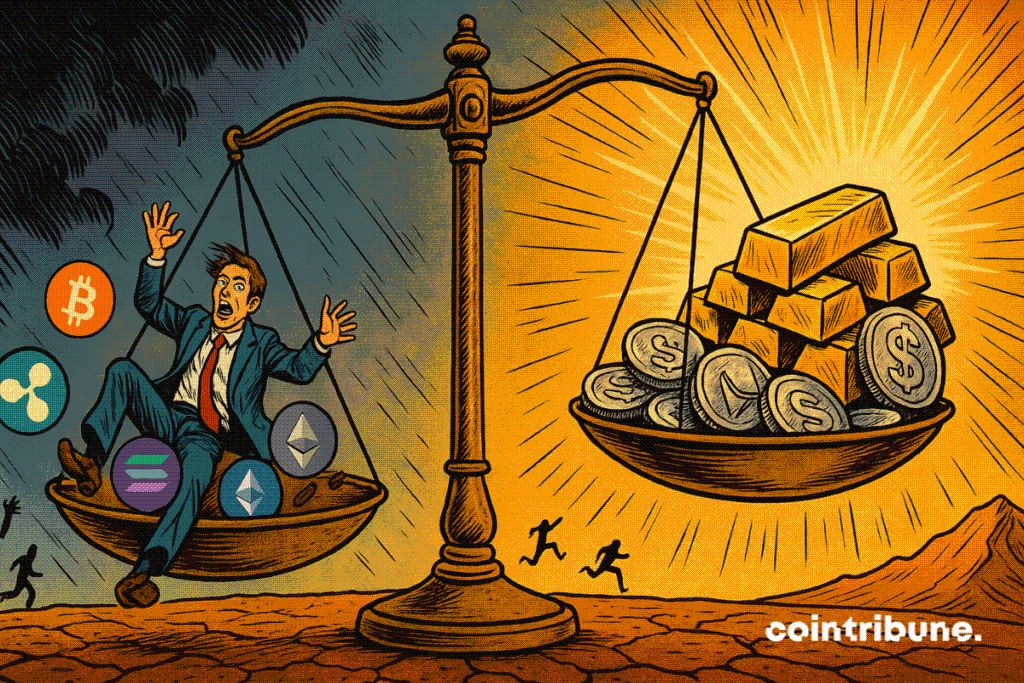Why Are Bitcoin, XRP, Solana and Ether Falling While Gold and Silver Surge?
The crypto market is going through a period of intense turbulence. While Bitcoin dangerously slips below the symbolic threshold of 100,000 dollars, gold and silver shine brightly. Investors are turning away from digital assets to seek refuge in commodities. But what explains such a turnaround?

In brief
- Bitcoin fell more than 9% this month, dropping below the psychological barrier of 100,000 dollars.
- The main cryptos (Ethereum, Solana, Dogecoin) recorded declines between 11% and 20%.
- Gold and silver increased by 4% and 9% respectively during the same period.
- Credit risks weighing on digital asset treasuries partly explain this weakness.
Bitcoin, Ethereum, Solana… Cryptos Fall
Bitcoin is going through an unprecedented turbulence zone. The world’s leading crypto broke below the symbolic 100,000 dollar mark, dragging the entire sector down with it.
Ethereum falls by 11%, Solana by 20%, while XRP limits damage with a 7% drop. This correction occurs even as the dollar index slows its growth, an environment normally favorable to digital assets.
Greg Magadini, Head of Derivatives Products at Amberdata, points to an exhaustion of positive catalysts .
All reasons for optimism have been exhausted, he explains. The Fed has ended its monetary easing cycle, the US government shutdown has concluded, and traders now find themselves without new support to justify buying.
The real danger comes from elsewhere. Digital asset treasuries, companies that have massively bought bitcoin through convertible bonds, face a liquidity threat.
They are competing for credit access with governments and AI giants. If credit markets seize up, these companies will have to sell their cryptos to repay debts.
A downward spiral could be triggered, warns Magadini. Each forced sale would force other holders to liquidate their positions. This systemic risk particularly threatens structures that acquired volatile altcoins at their highest levels.
Gold Shines on the Ruins of Public Debt
Precious metals experience a very different fate. Gold and silver attract investor flows seeking safety amid the deterioration of global public finances.
The situation is alarming: Japan shows a public debt-to-GDP ratio exceeding 220%, the United States crosses 120%, while France and Italy exceed 110%.
Robin Brooks, a researcher at the Brookings Institution, sees in this surge in precious metals “the symptom of a deeply failing fiscal policy”.
The Eurozone crystallizes these tensions, with heavily indebted countries influencing European Central Bank decisions. China is not spared this spiral, with total debt exceeding 300% of GDP.
This flight to quality even benefits less-followed metals. Palladium and platinum record gains above 1%. Investors favor these tangible assets amid regulatory uncertainty paralyzing the crypto sector.
A Turnaround in Sight?
History suggests that bitcoin could rebound. Analysts observe a lag of about 80 days between gold and bitcoin movements. Once the rise of the yellow metal stabilizes, the crypto could regain strength.
JPMorgan still maintains its target of 170,000 dollars over six to twelve months, based on a miner production cost set at 94,000 dollars. The coming weeks will be decisive.
The return of liquidity and clarification of US monetary policy will determine if this correction is just a breath or the beginning of a prolonged bear phase . Meanwhile, precious metals retain their status as undisputed safe havens.
Disclaimer: The content of this article solely reflects the author's opinion and does not represent the platform in any capacity. This article is not intended to serve as a reference for making investment decisions.
You may also like
Ethereum Updates: BitMine’s Fresh Leadership Fuels Ethereum Growth, Striving to Connect Wall Street with the Crypto World
- BitMine appoints Chi Tsang as CEO amid strategic overhaul, adding 3 board members to strengthen governance. - Company boosts ETH holdings by 34% to $12.5B, aiming to control 5% of Ethereum's supply through aggressive accumulation. - Institutional Ethereum buying accelerates as exchange balances hit multi-year lows, with BitMine trailing only Bitcoin-focused rivals. - Despite 35% stock decline and 13.4% ETH price drop, $398M cash reserves signal long-term blockchain asset tokenization bets.

Democratizing Access to Private Markets: How AI and Tokenization Are Transforming Global Finance
- IPO Genie tokenizes pre-IPO assets via AI, bridging traditional finance and blockchain with $500M+ AUM. - BlackRock's BUIDL fund expands to BNB Chain, reaching $2.3B market cap as institutional confidence grows. - Tokenization reduces cross-border costs and democratizes access to $3T private markets via retail investor participation. - IPO Genie's presale sees $0.05 price projections, DAO governance, and Fireblocks/CertiK security partnerships. - Nebraska's digital asset bank charter highlights evolving

Altcoin Enthusiasm Meets Federal Reserve Prudence: DeFi Faces a Critical Turning Point
- Crypto market shows Altcoin Season optimism with DeFi growth, high-yield products like CoinW's 50% APY offering, and rising altcoin valuations. - Ethereum-based DeFi project secures $18.7M in presale, nearing 18,000 token holders, with 250% MUTM token price surge signaling confidence. - Fed's potential 2025 rate cut pause and inflation risks could disrupt altcoin momentum, per J.P. Morgan analysts, amid 58% priced-in December cut probability. - UK cashback program integrating crypto rewards highlights ma

EU Crypto Regulations Struggle to Balance Centralized Oversight with Regional Knowledge
- EU Commission proposes centralizing crypto oversight under ESMA, replacing MiCA's national regulator model and sparking industry concerns over legal uncertainty and implementation delays. - Critics warn centralized control risks destabilizing MiCA's 2026 rollout, with national regulators arguing they maintain closer firm engagement and ESMA requiring significant resource boosts. - France and ESMA Chair Verena Ross support centralization for regulatory consistency, but timing concerns persist as national

